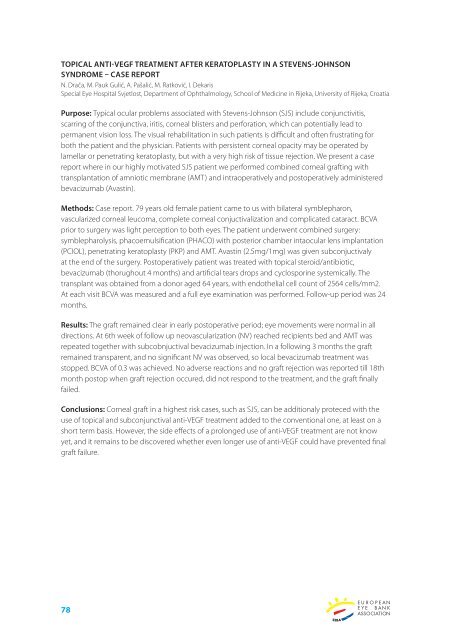EEBA Program (PDF/3MB) - EEBA - Annual Meeting
EEBA Program (PDF/3MB) - EEBA - Annual Meeting
EEBA Program (PDF/3MB) - EEBA - Annual Meeting
You also want an ePaper? Increase the reach of your titles
YUMPU automatically turns print PDFs into web optimized ePapers that Google loves.
TOPICAL ANTI-VEGF TREATMENT AFTER KERATOPLASTY IN A STEVENS-JOHNSONSYNDROME – CASE REPORTN. Drača, M. Pauk Gulić, A. Pašalić, M. Ratković, I. DekarisSpecial Eye Hospital Svjetlost, Department of Ophthalmology, School of Medicine in Rijeka, University of Rijeka, CroatiaPurpose: Typical ocular problems associated with Stevens-Johnson (SJS) include conjunctivitis,scarring of the conjunctiva, iritis, corneal blisters and perforation, which can potentially lead topermanent vision loss. The visual rehabilitation in such patients is difficult and often frustrating forboth the patient and the physician. Patients with persistent corneal opacity may be operated bylamellar or penetrating keratoplasty, but with a very high risk of tissue rejection. We present a casereport where in our highly motivated SJS patient we performed combined corneal grafting withtransplantation of amniotic membrane (AMT) and intraoperatively and postoperatively administeredbevacizumab (Avastin).Methods: Case report. 79 years old female patient came to us with bilateral symblepharon,vascularized corneal leucoma, complete corneal conjuctivalization and complicated cataract. BCVAprior to surgery was light perception to both eyes. The patient underwent combined surgery:symblepharolysis, phacoemulsification (PHACO) with posterior chamber intaocular lens implantation(PCIOL), penetrating keratoplasty (PKP) and AMT. Avastin (2.5mg/1mg) was given subconjuctivalyat the end of the surgery. Postoperatively patient was treated with topical steroid/antibiotic,bevacizumab (thorughout 4 months) and artificial tears drops and cyclosporine systemically. Thetransplant was obtained from a donor aged 64 years, with endothelial cell count of 2564 cells/mm2.At each visit BCVA was measured and a full eye examination was performed. Follow-up period was 24months.Results: The graft remained clear in early postoperative period; eye movements were normal in alldirections. At 6th week of follow up neovascularization (NV) reached recipients bed and AMT wasrepeated together with subcobnjuctival bevacizumab injection. In a following 3 months the graftremained transparent, and no significant NV was observed, so local bevacizumab treatment wasstopped. BCVA of 0.3 was achieved. No adverse reactions and no graft rejection was reported till 18thmonth postop when graft rejection occured, did not respond to the treatment, and the graft finallyfailed.Conclusions: Corneal graft in a highest risk cases, such as SJS, can be additionaly proteced with theuse of topical and subconjunctival anti-VEGF treatment added to the conventional one, at least on ashort term basis. However, the side effects of a prolonged use of anti-VEGF treatment are not knowyet, and it remains to be discovered whether even longer use of anti-VEGF could have prevented finalgraft failure.78


